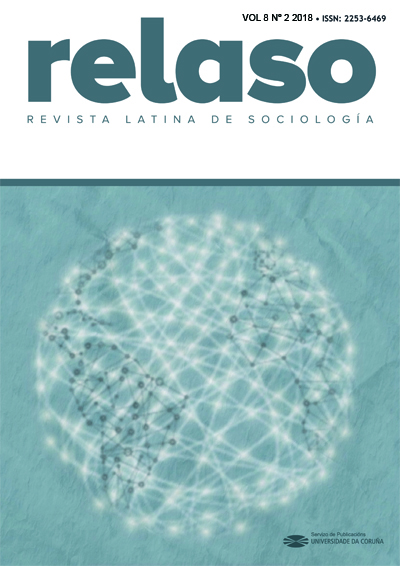Perception of welfare among young people from Spain and the Republic of Belarus
Main Article Content
Abstract
Young people are a group that is subject to different social and psychological factors that set them in situations of vulnerability. This circumstance affects the perception that this group has about their own well-being. Within this age group, the university students are who experience higher levels of stress which are liked to factors such as: exam periods, moving away from their homes or job instability. In this sense, different researches have shown that there are significant relationships between social, economic or psychological factors, and the unequal distribution of well-being. This inquiry is based on the hypothesis that, regardless of the territorial context (different countries), welfare is determined by socioeconomic and psychosocial variables. At the same time, between welfare and these variables, a significant and positive correlation is established that explains their trends of distribution. To validate this argument, a statistical analysis of the data provided by a survey among university students from Spain and the Republic of Belarus has been carried out (between 18 and 30 years of age). The outcomes of the research show the welfare behaves differently in both countries. But there is also evidence of common relationships regarding some variables towards welfare, (such as health and income). Those relationships have a key impact on the perception of the well-being of youth.
Keywords:
Downloads
Metrics
Article Details
References
Argyle, M. (1992). La Psicología de la felicidad. Madrid: Alianza.
Blanco, A.; Díaz, D. (2005). El bienestar social: su concepto y medición. Psicothema 2005. Vol. 17, nº 4, pp. 582-589.
Bourdieu, P. (1988). Las formas del capital; capital económico, capital cultural y capital social. En: Poder Derecho y Clases Sociales: 131-165. Ed. Desclee de Brouwer (Madrid)
Bradburn, N. (1969). The strucuture of psychological well-being. Chicago: Aldine.
Casas, F. (1996). Bienestar social. Una introducción psicosociológica. Barcelona: PPU.
Coleman, J. (1988). Social Capital in the Creation of Human Capital. The American Journal of Sociology, Vol. 94. The University of Chicago Press (Chicago) United States of America: 95-120.
Diener, E. (1994). El bienestar subjetivo. Intervención Psicosocial, 3, 67-113.
Durkheim, E. (1987). La División del trabajo social. Ed. Akal universitaria. Serie Sociología; Nº 39, Ed. Akal, D.L. (Madrid).
García, M. (2006).La salud como aproximación a la felicidad. Revista de estadística y sociedad. Nº. 14, 2006, pp. 9-11,
García-Viniegras, C., & González, I. (2000). La categoría bienestar psicológico. Su relación con otras categorías sociales. Rev Cubana Med Gen Integr, 16(6), 586-92.
González, I. (2011) Las personas felices se sienten más saludables y con menos problemas de salud. Sesenta y más, Nº. 307, 2011, pp. 42-45
González, J., Garcés, E. et. al. (2012). Indicadores de bienestar psicológico percibido en alumnos de educación física. Revista de psicología del deporte, Vol. 21, Nº 1, 2012, pp. 183-187
Granovetter, M. S. (1973). The strength of weak ties. American Journal of Sociology; vol 78, nº 6 (1973): 1360 - 1380. En: Política y Sociedad Nº33(2000): 41-56.
Haz-Gómez, F. E. (2015). El capital social y la universidad: estudio sobre la influencia de la universidad en la construcción del capital social de los jóvenes. Tesis doctoral. Universidade da Coruña (España)
Haz-Gómez, F. E. (2017). Capital social de acceso: desigualdad entre jóvenes a través de sus redes sociales. Revista San Gregorio (Ecuador): 17 (56-69)
Herreros, F. (2002). ¿Son las relaciones sociales una fuente de recursos?: una definición del capital social. Papers: revista de sociología, Nº 67, (2002): 129-148.
Lin, N. (2001). Social Capital: A Theory of Social Structure and Action. Ed. Cambridge University Press (Cambridge) UK.
Lin, N. (2008). A Network Theory of Social Capital. En: Castiglione, D.; Van Deth, J. W.; Wolleb, G. (eds.) The handbook of social capital. Oxford University Press (Oxford) UK: 50-69.
Organización Mundial de la Salud (1946) Constitución de la Organización Mundial de la Salud. Ed. OMS (Nueva York) (Official Records of the World Health Organization, Nº 2, p. 100)
Putnam, R. (1993). La comunidad próspera. El capital social y la vida pública. En Zona Abierta Nº94-95 (2001):89-104. Original: “The Prosperous Community. Social Capital and Public Life” The American Prospect Nº13, (1993): 35-42.
Putnam, R. D. (2000). Bowling alone: the collapse and revival of American community. New York: Simon and Schuster
Putnam, R. (2002). Solo en la Bolera; Colapso y resurgimiento de la comunidad norteamericana. Ed. Galaxia Gutemberg (Madrid).
Real, J.E. (2016). Manual de investigación para ciencias sociales y de la salud en grado y posgrado. Ed. Universidad Técnica Particular de Loja (Loja) Ecuador.
Simmel, G. (1926). Fidelidad y gratitud. Revista de Occidente, Nº 42 (1926): 292-317.
Veenhoven, R. (1994). El estudio de la satisfacción con la vida. Intervención Psicosocial, 3, 87-116.



